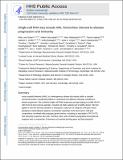| dc.contributor.author | van Galen, Peter | |
| dc.contributor.author | Hovestadt, Volker | |
| dc.contributor.author | Wadsworth II, Marc H. | |
| dc.contributor.author | Hughes, Travis K. | |
| dc.contributor.author | Griffin, Gabriel K. | |
| dc.contributor.author | Battaglia, Sofia | |
| dc.contributor.author | Verga, Julia A. | |
| dc.contributor.author | Stephansky, Jason | |
| dc.contributor.author | Pastika, Timothy J. | |
| dc.contributor.author | Lombardi Story, Jennifer | |
| dc.contributor.author | Pinkus, Geraldine S. | |
| dc.contributor.author | Pozdnyakova, Olga | |
| dc.contributor.author | Galinsky, Ilene | |
| dc.contributor.author | Stone, Richard M. | |
| dc.contributor.author | Graubert, Timothy A. | |
| dc.contributor.author | Shalek, Alex K. | |
| dc.contributor.author | Aster, Jon C. | |
| dc.contributor.author | Lane, Andrew A. | |
| dc.contributor.author | Bernstein, Bradley E. | |
| dc.date.accessioned | 2020-05-11T19:28:19Z | |
| dc.date.available | 2020-05-11T19:28:19Z | |
| dc.date.issued | 2019-03 | |
| dc.date.submitted | 2018-12 | |
| dc.identifier.issn | 0092-8674 | |
| dc.identifier.uri | https://hdl.handle.net/1721.1/125158 | |
| dc.description.abstract | Acute myeloid leukemia (AML) is a heterogeneous disease that resides within a complex microenvironment, complicating efforts to understand how different cell types contribute to disease progression. We combined single-cell RNA sequencing and genotyping to profile 38,410 cells from 40 bone marrow aspirates, including 16 AML patients and five healthy donors. We then applied a machine learning classifier to distinguish a spectrum of malignant cell types whose abundances varied between patients and between subclones in the same tumor. Cell type compositions correlated with prototypic genetic lesions, including an association of FLT3-ITD with abundant progenitor-like cells. Primitive AML cells exhibited dysregulated transcriptional programs with co-expression of stemness and myeloid priming genes and had prognostic significance. Differentiated monocyte-like AML cells expressed diverse immunomodulatory genes and suppressed T cell activity in vitro. In conclusion, we provide single-cell technologies and an atlas of AML cell states, regulators, and markers with implications for precision medicine and immune therapies. Video Abstract: A combination of transcriptomics and mutational analyses in single cells from acute myeloid leukemia patients reveals the existence of distinct functional subsets and their associated drivers. | en_US |
| dc.language.iso | en | |
| dc.publisher | Elsevier BV | en_US |
| dc.relation.isversionof | http://dx.doi.org/10.1016/j.cell.2019.01.031 | en_US |
| dc.rights | Creative Commons Attribution-NonCommercial-NoDerivs License | en_US |
| dc.rights.uri | http://creativecommons.org/licenses/by-nc-nd/4.0/ | en_US |
| dc.source | PMC | en_US |
| dc.title | Single-Cell RNA-Seq Reveals AML Hierarchies Relevant to Disease Progression and Immunity | en_US |
| dc.type | Article | en_US |
| dc.identifier.citation | van Galen, Peter et al. "Single-Cell RNA-Seq Reveals AML Hierarchies Relevant to Disease Progression and Immunity." Cell 176, 6 (March 2019): P1265-1281.e24 © 2019 Elsevier Inc | en_US |
| dc.contributor.department | Massachusetts Institute of Technology. Department of Chemistry | en_US |
| dc.contributor.department | Massachusetts Institute of Technology. Institute for Medical Engineering & Science | en_US |
| dc.contributor.department | Koch Institute for Integrative Cancer Research at MIT | en_US |
| dc.relation.journal | Cell | en_US |
| dc.eprint.version | Author's final manuscript | en_US |
| dc.type.uri | http://purl.org/eprint/type/JournalArticle | en_US |
| eprint.status | http://purl.org/eprint/status/PeerReviewed | en_US |
| dc.date.updated | 2020-03-17T17:17:52Z | |
| dspace.date.submission | 2020-03-17T17:18:37Z | |
| mit.journal.volume | 176 | en_US |
| mit.journal.issue | 6 | en_US |
| mit.license | PUBLISHER_CC | |
| mit.metadata.status | Complete | |
